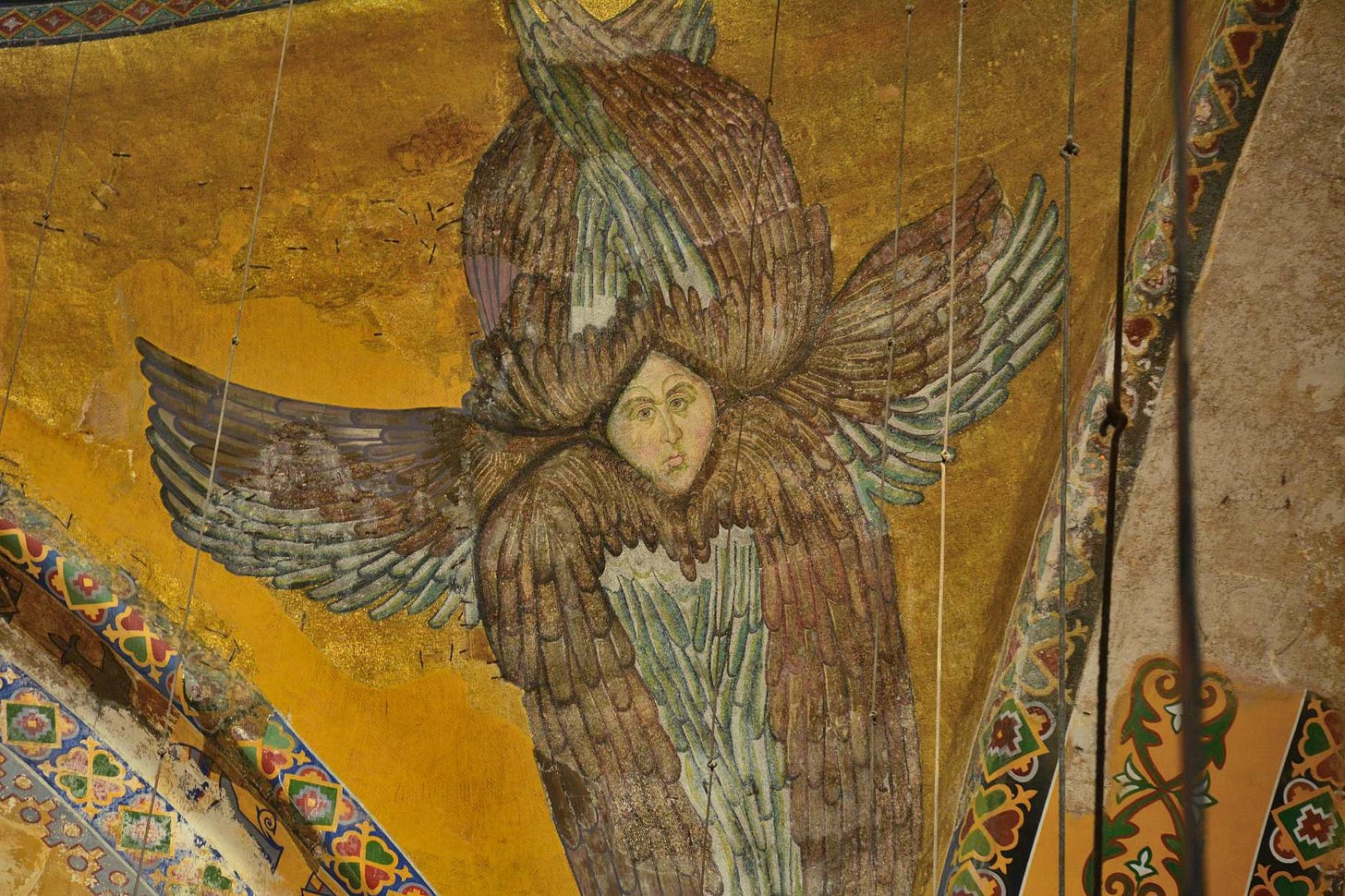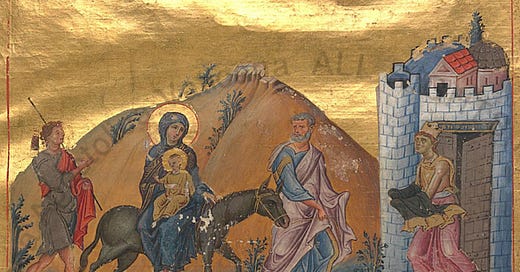Pasts Imperfect (2.20.25)
Ancient and Modern Immigration, Amazonian "Garden Cities," Cuneiform School Exercises, Greco-Egyptian Scribes Penning Magical Handbooks, and Much More

This week, New Testament scholar and apocalypse expert Steven J. Friesen discusses a new book on American immigration and references to the book of Revelation. Then, a new report on the state of Palmyra, the merchant guilds of the Chola Dynasty in South Asia, recovering Amazonian "Garden Cities," cuneiform school exercises, magic handbooks and the Greco-Egyptian scribes who wrote them, new ancient world journals, the famed Torlonia Marbles arrive in Chicago, and much more.
How the Book of Revelation Shaped American Immigration by Steven J. Friesen
In Immigration and Apocalypse: How the Book of Revelation Shaped American Immigration, historian Yii-Jan Lin presents a fascinating study on the intersection of immigration and the book of Revelation in the United States. The book of Revelation is regularly evoked and quoted by politicians in mainstream media. But to what end? Early on, Lin cites a suggestive Fox News interview with Rev. Robert Jeffress from December 22, 2018 (168-169).
A Democratic lawmaker had opposed funding for a wall along the US/Mexico border, and Rev. Jeffress responded. The main interviewer was Fox host Pete Hegseth, who is now Secretary of Defense in the second Trump administration. “You know,” said Jeffress, “I had the privilege of preaching the sermon before President Trump’s inauguration [on Jan. 20, 2017], and… I chose the Old Testament story of God telling Nehemiah to build the wall around Jerusalem. And I said, ‘Mr. President, God is not against walls. Walls are not un-Christian.’ The Bible says even heaven is gonna have a wall around it. Not everyone’s gonna be allowed in.” Hegseth then concluded, consulting his phone for a verse from Revelation about the eschatological New Jerusalem, “You mentioned the wall in heaven. Revelation 21:17 says…the angel measured the wall using human measurement. It was 144 cubits thick. Don’t know what that was in inches but probably pretty thick. [Co-host laughs in agreement.]” The megachurch pastor and the two news jockeys finished by wishing each other a merry Christmas.
That interview illustrates the central argument of Lin’s book: the power structures of White America mythologize the nation as an embodiment of the apocalyptic New Jerusalem that needs protection from dangerous foreigners in this world. Or, in Lin’s words:
Revelation and its apocalyptic vision of the divine city, the New Jerusalem, have served as a central founding myth for America and a powerful metaphor for American identity, belonging, and exclusion… This makes for a compelling portrait of a land of promise destined for greatness, shining with riches, with gates flung wide in welcome…but only for those whose names are written in the Book of Life (2-3).
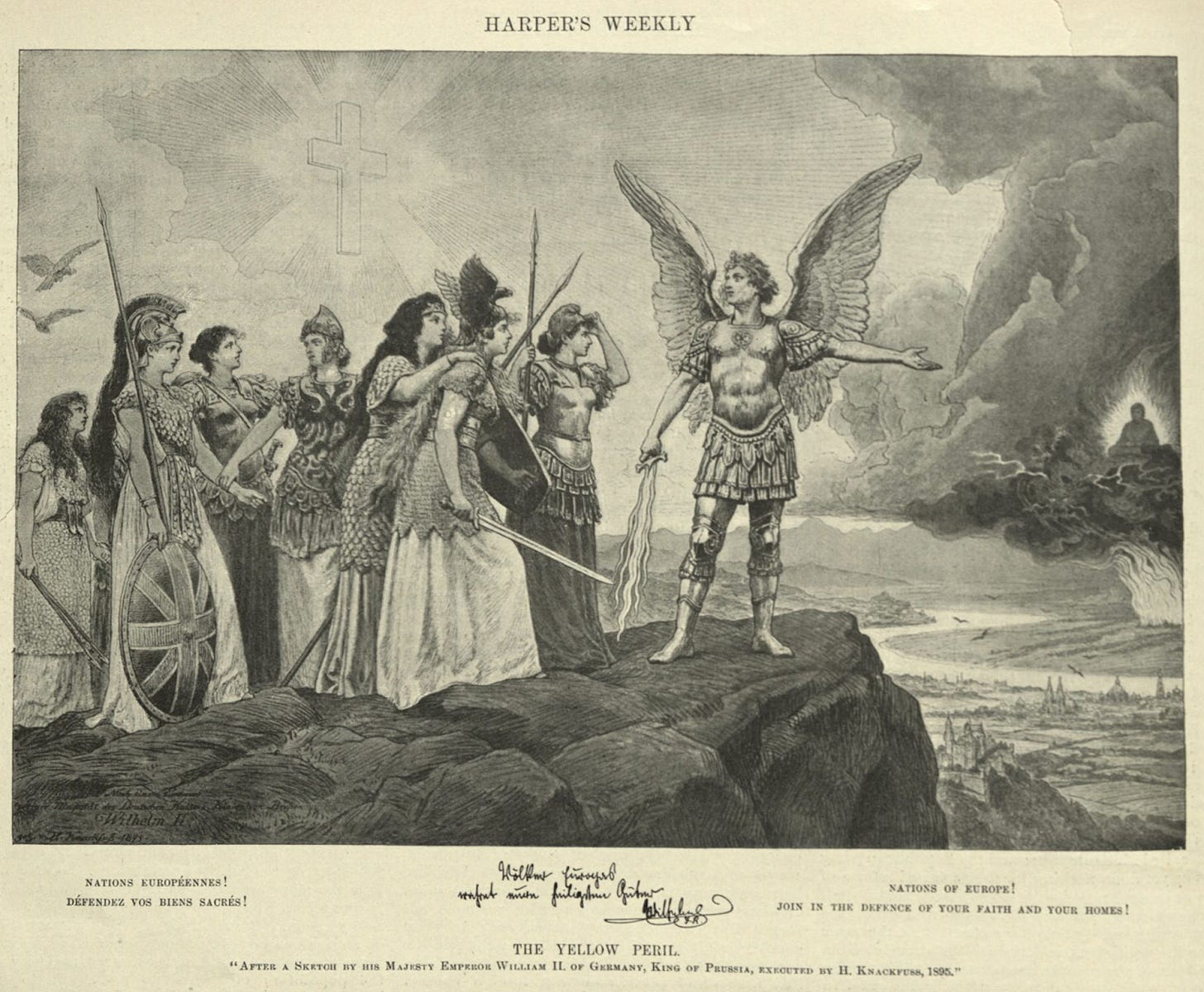
Lin lays out a foundational case for the US-as-New-Jerusalem mythology in the first chapter of the volume. The historical review samples important moments and culminates in a skillful dissection of President Ronald Reagan’s farewell speech to the nation (11 January 1989). In that speech, Reagan’s optimistic ideology of America as a shining city on a hill belies its axioms that white people are by nature worthy of citizenship, and that people of color are by nature impure and a threat to American identity.
It would be easy to overread Lin’s point here. She does not argue that the ancient rhetoric and imagery of Revelation singularly determined modern American attitudes and policies about immigrants. Rather, the point is that “the utility of the New Jerusalem metaphor lies chiefly in its recyclability… America as the New Jerusalem continues to be used and reused for its political expediency to both inspire and incite” (180). Thus, Revelation’s eschatological expectations are exploited for political agendas, and in this way Revelation shapes the destinies of many peoples, increasing privilege for some and misery for others.

Subsequent chapters develop historical perspective, critical nuance, and salient themes. There was, for example, a complicated interplay between the need for the labor of Chinese immigrants to the US in the 19th century and the desire to exclude those same immigrants from participation in dominant society. As the numbers of East Asian immigrants increased, this “Yellow Peril” was portrayed as a threatening horde, described by politicians, preachers, novelists, and cartoonists in terms that mirror Revelation’s rhetoric of exclusion. The immigrants were impure: a plague, pests, invaders (e.g., Rev 20:7-15; 21:7-8, 27; 22:14-15). Even the Great Dragon of Revelation 12 was used to explain the dragon dances from Chinese festivals. This apocalyptic exclusion framed in terms of dirt, poverty, sin, and disease was used against other groups as well, and so the book includes discussions devoted to the “apocalyptic epidemiology” (my favorite new term) that pathologized Native Americans, Blacks, Mexicans, Muslims, Jews, Catholics, and others.
Later chapters in the volume focus especially on the mechanisms of exclusion; that is, the ways in which regulations, laws, bureaucracies, and documentation created the appearance of opportunity while simultaneously multiplying the possibilities for rejection and exclusion. These mechanisms fed legal disputations, public discontent, and political rationalizations regarding the exclusion of immigrants and of Native people. The central question of these arguments was: who was White enough to merit citizenship?
I expect that the volume will encounter resistance among interpreters who follow more traditional approaches to Revelation. Some might suggest that it strays too far from the text of Revelation; or that it covers too many centuries too quickly; or that the subject itself is eccentric and beneath the dignity of Christian theology. To such possible objections, I note that the interpretation of ancient texts has for too long been the privilege of people who present as I do—cis men who appear to be from families originating in Northern Europe (i.e. people who have benefitted from the apocalyptic epidemiology of exclusion and from various kinds of systemic favor, sometimes for generations, sometimes for centuries).
In fact, my own immigration history illustrates the historical and material interests that are often occluded by such academic interpretive privilege. In the 1870s Chinese immigrants to the US were facing growing legal and illegal violence. The transcontinental railroad was complete, and the need for their labor on that national project was over just as their numbers were increasing. But they were not invited to develop the newly accessible land along those rail corridors. They were instead subjected to legal barriers designed to exclude them from American society. Native Americans could not fill that role either, for they were at that time being forcibly expelled from those lands and confined to small reservations in “Indian Territory.” Nor were newly-freed Black Americans given the mission of transforming the native prairies into agricultural tracts. Black Americans were instead subjected to other forms of exclusion and discrimination from which the US is not yet free.
In the 1870s the railroad companies did, however, encourage Mennonite communities—North Europeans who had moved Ukraine—to relocate once more to the newly accessible lands along the railroad corridors from which Natives had been removed. My ancestors were thus able to immigrate, to possess native prairies through capitalist laws of private ownership, and to convert those prairies into farms. The immigrants of North European descent built churches, became citizens, started boarding schools for Native children, established colleges, and sent Christian missionaries to East Asia.
With that kind of background, it would never have occurred to me to write about Revelation and immigration. My stunted imagination has material roots and social parameters, and those limits are directly related to the parameters that guard the academic boundaries around what can and cannot be said about ancient texts. Academia needs studies like this that raise suppressed questions if we are to understand better the ancient texts, their histories of usefulness, our academic disciplines, and our contemporary societal struggles.

Global Antiquity and Public Humanities
On December 8, 2024, Syria was liberated from the Assad regime. A new report from the group Palmyrene Voices—headed by Hasan Ali, Isber Sabrine, Mohammad Al Fares, and 15 other archaeological and local sources—looks at the current state of the site. They note that 80% of the buildings have been destroyed or are unstable. Only 10,000 of the 100,000 regular residents of Palmyra have returned and the site is covered in land mines or weapons. The report assesses numerous structures on site, including the Palmyra Archaeological Museum, the Ayyubid Castle, and the Theater. They note that rebuilding the site needs funding and support, but that local residents also need to be included in any cultural heritage decisions going forward.
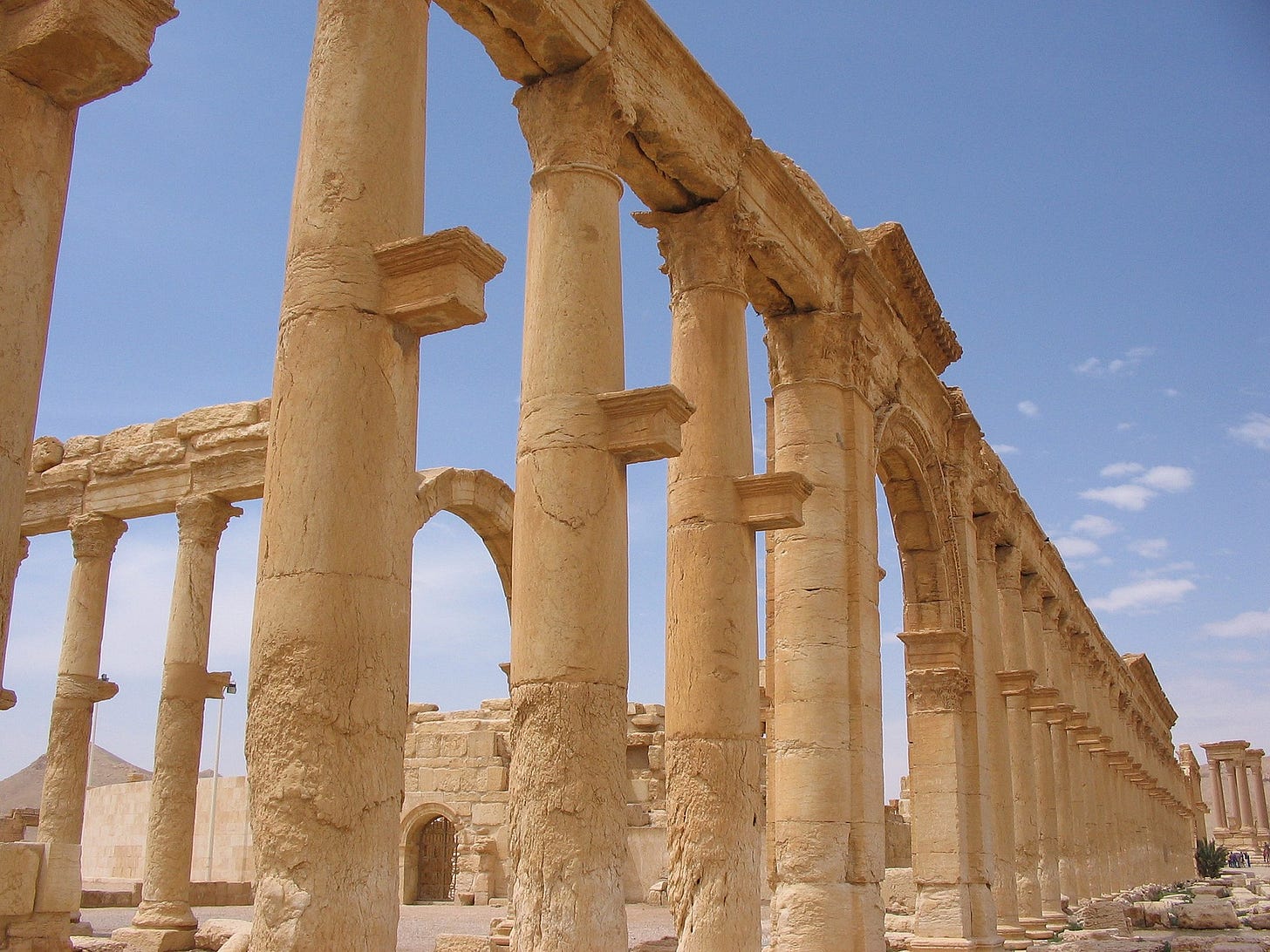
In his forthcoming book, Lords of Earth and Sea: A History of the Chola Empire, public historian and podcaster Anirudh Kanisetti looks at the medieval empire of the thalassocratic Chola Dynasty (ca. 850-1279 CE) in South Asia. As Kanisetti discusses in a new article for the Economic Times, the merchant guild known as the Five Hundred Lords of Ayyavole was the “secret of their strength.”
Merchants belonged both to the country and the court. They were the crucial connective tissue of the medieval world. Alongside Chola conquests, merchant assemblies brought the southern Deccan, the Malabar and Coromandel coasts and northern Lanka into deep, invigorating regional exchange.
Hurray for histories exploring the power and influence of trade associations.
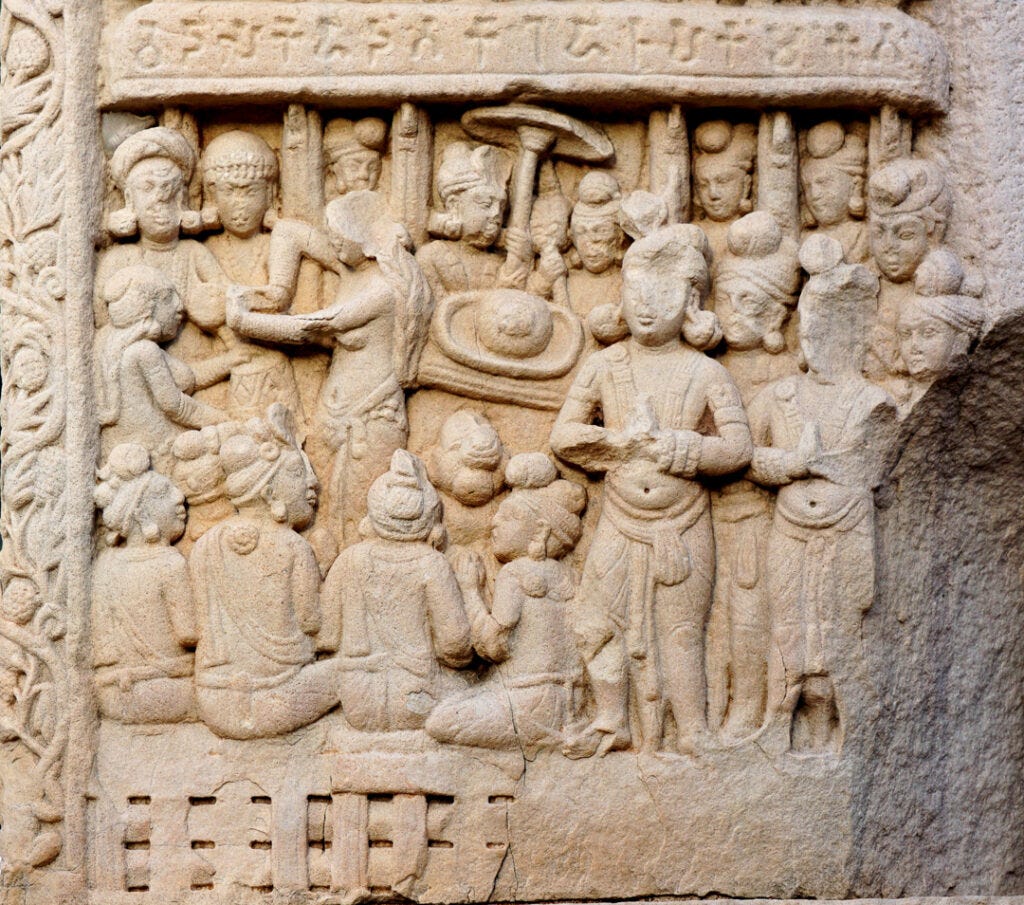
In Hyperallergic, Maya Pontone notes the presence of a co-winner of the Vesuvius Challenge on the staff of Elon Musk's "Department of Government Efficiency". The twenty-three-year-old Luke Farritor is apparently using the AI skills he used to help decipher an un-opened scroll from Herculaneum to purge the federal government, censor government web pages, and disrupt scientific and medical research. It turns out that the Musk Foundation bankrolls part of the Vesuvius Challenge, as well as archaeological and conservation initiatives through the American Institute for Roman Culture (AIRC). This would seem to reflect the somewhat hackneyed fascination of would-be authoritarians with the Roman Empire—or at least of their cartoon, laundered version of it.
At the ISAW Library Blog, Gabriel Mckee, Librarian for Collections and Services, discusses “Archaeological Tourism in Mark Twain’s Innocent Abroad” in conjunction with the current Grolier Club exhibit: “A First-Class Fool: Mark Twain and Humor.” And manuscript expert Aaron Macks has his latest rundown of the newest manuscripts digitized by the Biblioteca Apostolica Vaticana. Honestly, I was stoked to see that a 15th century copy of Heliodorus written by the scribe Ἰσίδωρος καρδινάλιος is now available (Vat.gr.1698).
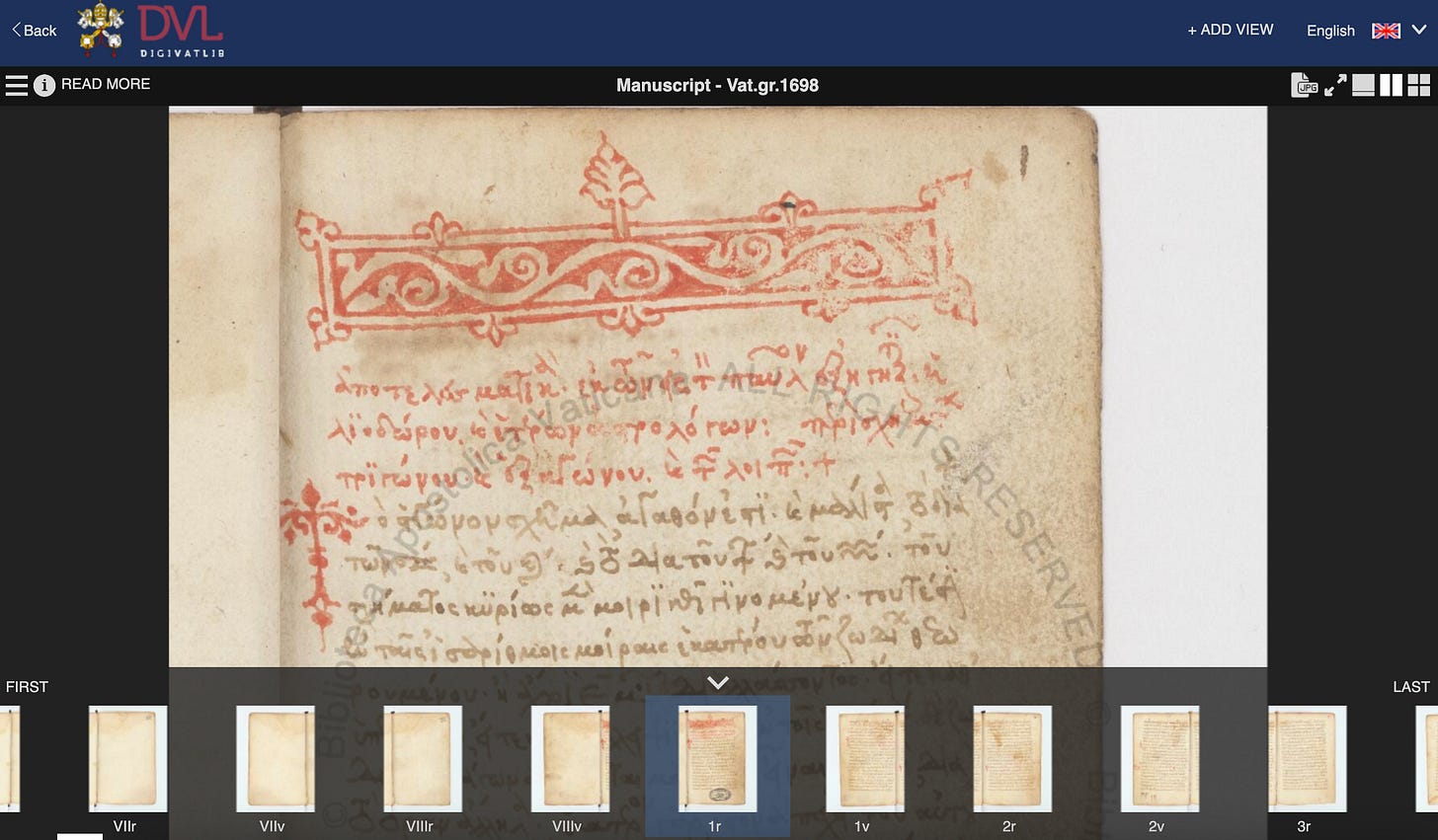
Reporter Mac Margolis at The Guardian reports on ancient cities of the Amazon, which researchers have been exploring using LiDAR (light detection and ranging) scanning. Used in the recent past to analyze ancient Maya cities in Central America, LiDAR now takes center stage in South America to interpret “garden cities” of the Amazon basin. An in the northern Oued Laou valley close to the Strait of Gibraltar, archaeologists from the University of Barcelona “discovered the Maghreb’s first pre-Phoenician settlement, where they found evidence of a Bronze Age village that challenges assumptions about the region’s history.” Their findings were published in Antiquity this week.
Congrats to Monica H. Green and Nahyan Fancy on the open access publication of their article, “Plague history, Mongol history, and the processes of focalisation leading up to the Black Death: a response to Brack et al,” in the journal Medical History. And a new article by Sofía Torallas Tovar on “Compilers of Magic: Greco-Egyptian Magical Handbooks through the Eyes of Their Scribes,” is out now in the Proceedings of the American Philosophical Society. She focuses on the scribes and materiality of magic texts to provide “a window into the transmission of ancient technical knowledge, which may teach us something about magical texts, but also about other fields, like medicine, pharmacology, liturgy, and even cuisine.”
Historian and PI friend Moudhy Al-Rashid has a new book, Between Two Rivers: Ancient Mesopotamia and the Birth of History. Over at The Guardian, they have already named it a book to look forward to in 2025. Al-Rashid is also an amazing follow for her translations of cuneiform tablets on Bluesky. Congrats on your book coming out today in the U.K., Prof. Al-Rashid!
New Antiquity Journal Issues (by yaleclassicslib.bsky.social)
Acta Antiqua Academiae Scientiarum Hungaricae Vol. 64, No. 1 (2024) Plotinus' notion of the soul and its aftermath
AL. Rivista di studi di Anthologia Latina Vol. 15 (2024)
American Journal of Philology Vol. 145, No. 4 (2024) #openaccess*
Cahiers « Mondes anciens » Vol. 19 (2025) #openaccess Chrétiens ariens et nicéens en Afrique vandale (Ve-VIe siècles)
The Cambridge Classical Journal Vol. 70 (2024) NB Daniel Pellerin “A Riddle Wrapped in a Mystery: The Elusive E at Delphi”
Comunicazioni dell’Istituto Papirologico «G. Vitelli» Vol. 15 (2024) #openaccess
Dike: Rivista di Storia del Diritto Greco ed Ellenistico #openaccess Vol. 27 (2024)
Greek, Roman, and Byzantine Studies Vol. 65, No. 1 (2025) #openaccess
Illinois Classical Studies Vol. 49, Nos. 1-2 (2024) NB Sheena Finnigan “Reconsidering the Relationship between Motherhood, Non-motherhood, and Work among Urban Roman Freedwomen”
Heródoto Vol. 9, No. 1 (2024) #openaccess Antiguidade, nacionalismos e identidades complexas na historiografia ocidental
International Journal of the Classical Tradition Vol. 32, No. 1 (2025) NB Talia Boylan “Alciato’s Local Livy”
New Voices in Classical Reception Studies No.14 (2024) #openaccess
Phoenix Vol. 78, Nos. 1-2 (2024)
Pylon: Editions and Studies of Ancient Texts Vol. 6 (2024) #openaccess
Synthesis Vol. 32 No. 1 (2025) #openaccess
Zephyrvs Vol. 94 (2024) #openaccess
Antiquity Vol. 99, No. 403 (2025)
Bibliotheca Orientalis Vol. 81, Nos. 1-2 (2024)
De Antiquorum Artibus Et Civilisatione Studia Varia = Studies in Ancient Art and Civilisation Vol. 28 (2024) #openaccess
Journal of Semitic Studies Vol. 70, No. 1 (2025)
Almagest Vol. 15, No. 2 (2024)
Apeiron Vol. 58, No. 1 (2025)
History and Philosophy of Logic Vol. 45, No. 4 (2024)
Journal for the History of Rhetoric Vol. 27, No. 3 (2024) NB Drew Kopp & Hans-Friedrich Mueller “De figuris: Rediscovering Publius Rutilius Lupus”
Journal of the History of Philosophy Vol. 63, No. 1 (2025) #openaccess*
Journal of the Australian Early Medieval Association Vol. 20, No. 1 (2024)
*Now #openaccess through Project Muse’s Subscribe to Open (S20) initiative
Exhibitions, Workshops, and Lectures
Join the Newberry Library tonight, February 20 at 6pm CT, for a meet-the-author event with historians Eric Zimmer and Douglas Kiel to learn more about Native nations' #LandBack movement. “They will discuss how the Meskwaki, or ‘Red Earth People,’ have negotiated shifting environmental, economic, and political circumstances to rebuild in the face of incredible pressures.” Stream it here.
The William Leo Hansberry Society is hosting a roundtable Zoom, "Engaging Ethiopia", on Saturday, February 22 from 12:30 - 2:30PM ET. Please register here.

The Special Collection Research Center at Syracuse University Libraries will host “Collecting the Medieval Book in America”: A Keynote Lecture, ’Since the Census: A Century of Manuscript Collecting in North America’ by Lisa Fagin Davis, and Panel Discussion” beginning at 4pm EST on February 26, 2025.
On March 1, 2025, at 2:00 pm PT (5:00 pm ET) via Zoom, there will be a Webinar: Q&A with Immigration Lawyer Srividya Krishnamurthy. “Join Classics and Social Justice, an SCS Affiliated Group, for a conversation about the current state of affairs with student visas, immigrant visas, international travel, and a range of other topics.” Register for the webinar here.
The “Myth and Marble: Ancient Roman Sculpture from the Torlonia Collection” exhibition commences at the Art Institute in Chicago on March 15, 2025 and runs until June 29, 2025. You can search the current database of the marbles here prior to the exhibition opening on the Ides.
There will be a webinar on “New Directions in Ancient Medical Research” on April 8, 2025 from 3:30–5:00 PM EST: “Join four [SCS] Goodwin prize winners—Claire Bubb, Colin Webster, Kassandra Miller, and Aileen Das—to discuss how they settled on the topic of their first monographs, the publication process, and the feedback they received along the way.” To register, use this link.
